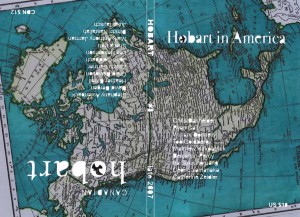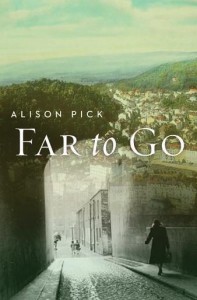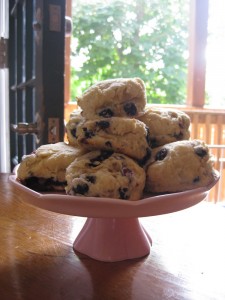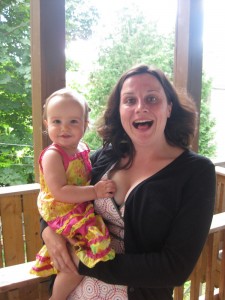August 20, 2010
If all else fails
So it turns out that I have a motto after all, because surely I’ve been saying this for years, but then Barbara Pym had been saying it for longer, so I read in her collected letters and diaries. The motto is (and it’s a good one, I think): “…if all else fails, we can always start a teashop.” Indeed.
August 19, 2010
Sometimes just laziness
Hmm. I’ve written before about how much I love recurring secondary characters throughout an author’s works, which creates the sense of a self-contained universe with millions of tiny whirling lives that I’m privy to glimpses of– in books by Margaret Drabble, and Barbara Pym. But how interesting then to read in a letter from Pym to Philip Larkin: “With me it’s sometimes just laziness– if I need a casual clergyman or anthropologist I just take one from an earlier book. Perhaps really one should take such a very minor character that only the author recognises it, like a kind of superstition or a charm.”
August 19, 2010
The magic of arrival
“Underneath it all, I’m sure I like the idea of travel much more than the reality. Not the being there, but the sense of motion, the magic of arrival. Destinations can be uncomfortable, bumpy, dirty, replete with bad food, hard beds and cold showers. In a hotel room, a cockroach scuttles across the floor, and I feel twinges of homesickness, a mourning for the warmth of the known. But mostly, when I land, there is often disappointment. Imagination is the lie I’ve been telling myself.” –Charlotte Gill, “Travelling Lessons” from the wondrous Room 33.2
August 17, 2010
A few good things
1) I am now reading A Very Private Eye: An Autobiography in Diaries and Letters of Barbara Pym
2) Heather Mallick is back columning at The Star.
3) India Knight’s fitting list of ultimate comfort reads
4) I am obsessed with Bruce Springsteen’s “Brilliant Disguise”
5) (late entry) Banana Nut Cheerios (which I bought because the box label contained “Banana Fun Facts” [and really, what is more fun than banana facts?)l
August 16, 2010
On Literary Maps
 Some books I’ve finished lately (Galore anybody?), I put down and think, “My god, if only the text had come with an accompanying map.” Now granted, an author should set the scene so vividly that the map is drawn with words, but for me, there is something so mesmerizing about actual maps in books. As a child, I would actually play with them, imagining characters’ ways along rivers and roads. As an adult reader, I just find them beautiful, and appreciate the extra layer of experience they add to the book. I am also a bit obsessed with fiction with appendices, as a postmodern quirk.
Some books I’ve finished lately (Galore anybody?), I put down and think, “My god, if only the text had come with an accompanying map.” Now granted, an author should set the scene so vividly that the map is drawn with words, but for me, there is something so mesmerizing about actual maps in books. As a child, I would actually play with them, imagining characters’ ways along rivers and roads. As an adult reader, I just find them beautiful, and appreciate the extra layer of experience they add to the book. I am also a bit obsessed with fiction with appendices, as a postmodern quirk.
I perused my library tonight to select some books with maps inside. The House at Pooh Corner was an obvious choice, with the “100 Aker Wood” map, which includes (of course), “the place where the wozzle wasn’t”. This was one of the fictional maps that Joan Bodger and family attempted locate in reality in How the Heather Looks, along with the map from Swallows and Amazons.
My lovely Snowbooks edition of Virginia Woolf’s The London Scene has a charming map of London in the front endpapers, with drawings of all the landmarks noted by Woolf in her essays. The back endpapers is London on a different scale, with Woolf’s own residences noted (22 Hyde Park Gate!).
Will Ferguson’s Hokkaido Highway Blues has a somewhat unremarkable map on Japan just inside the cover, but without it we wouldn’t quite get the weight of the fact that Ferguson travelled the country from tip-to-tip. I bought this book just before we moved in Japan in 2004, to the city of Himeji, which made the sub-map on page 148 very remarkable, because the map shows that Ferguson made Himeji a stop along his way. “At Himeji Castle, the flowers were in full bloom and everywhere there was activity and laughter.”
Hobart 8 wears its map on its cover. I bought it at City Lights Books in 2008 because it was beautiful and contained a story by  Stephany Aulenback, and I have a vivid memory of reading the whole thing on the green grass of Dolores Park (in February!). The southernmost half of the issue is American writers, North is Canadian whose lineup was pretty much unknown to me at the time but they’re writers who’ve been pretty much everywhere since– Heather Birrell, Craig Davidson, Zsuzsi Gartner, Lee Henderson, and Mark Anthony Jarman. I saw them here first. Map is by Robert Waters.
Stephany Aulenback, and I have a vivid memory of reading the whole thing on the green grass of Dolores Park (in February!). The southernmost half of the issue is American writers, North is Canadian whose lineup was pretty much unknown to me at the time but they’re writers who’ve been pretty much everywhere since– Heather Birrell, Craig Davidson, Zsuzsi Gartner, Lee Henderson, and Mark Anthony Jarman. I saw them here first. Map is by Robert Waters.
Patricia Storms’ The Pirate and the Penguin is delightful all over, but my favourite corners are the maps on her endpapers. “Map of the really boring (and cold!) South Pole” on the first endpapers, with such landmarks as Chilly Cove and Yawny Yogaland. “Map of the hot and itchy Caribbean” is on the back, with “Drives Me Coconuts Island” and a chest of “Boring Treasure”. Love it.
Though the first literary map I gave my heart to was in The Long Secret by Louise Fitzhugh. A map of Water Mill, where Harriet Welch is spending the summer with Beth Ellen, I was totally obsessed with this one, and I’m sure why because it’s pretty sparsely detailed, but I suspect the particular hand of Fitzhugh herself may have something to do with it.
My copy of Andrea Barrett’s story collection Servants of the Map is chock-full of images, and it’s unsurprising that a map would be one of them (along with gorgeous drawings of wildlife and taxonomic classifications). The title story is illustrated with “Sketch Map to accompany the Geological Notice of Kashmir”.
A map in a poetry collection! I was thrilled to find a vintage guide map to Los Alamos in Michael Lista’s Bloom.
And finally, Annie Dillard’s An American Childhood has for its endpapers “Pittsburgh about 1800”, even though Dillard’s book is about Pittsburgh in the mid-twentieth century, but Annie Dillard is always tricky, isn’t she?
Though I can’t finish without a mention of the map in Janice Kulyk Keefer’s The Ladies’ Lending Library. Which doesn’t even exist, but I was convinced it did, and leafed through the book about five times tonight looking for it. And that I haven’t read the story for a few years, but its managed to leave a map emblazoned upon my mind is really quite a testament to Kulyk Keefer’s depiction of place.
August 15, 2010
The Toronto Women's Bookstore, how I became a feminist (and how I learned to be alone)
 Last Thursday, it was my absolute pleasure to be buying books at the Toronto Women’s Bookstore (and the book was Sweet by Dani Couture, if anyone’s asking, along with C is for Coco). It was my absolute pleasure, because a few months ago it looked like I might never be buying books at the TWB again, and I was a bit heartbroken about that. Although I hadn’t been around to the bookstore for a long time, truthfully, but about ten years ago, the Toronto Women’s Bookstore saved my life.
Last Thursday, it was my absolute pleasure to be buying books at the Toronto Women’s Bookstore (and the book was Sweet by Dani Couture, if anyone’s asking, along with C is for Coco). It was my absolute pleasure, because a few months ago it looked like I might never be buying books at the TWB again, and I was a bit heartbroken about that. Although I hadn’t been around to the bookstore for a long time, truthfully, but about ten years ago, the Toronto Women’s Bookstore saved my life.
It all has to do with how I became a feminist, which, interestingly enough, has much to do also with how I learned to be alone. I can’t remember exactly what the catalyst was, but it all had to do with magazines like Bitch and Bust, and this place where I could go to buy them. But I’ll backtrack to just before that, to when I was about twenty, and would pick up a copy of Cosmo if I needed something to read on a long journey. I didn’t know that there was an alternative to that kind of media, and I was also the type of girl who claimed to be a “humanist”, because “feminist” was too confrontational, too exclusive.
I was also totally, and completely boy crazy, in a way that I never entirely got over, and there’s nothing really wrong with this, except that it seemed a boy’s opinion of me was my sole determination of self-worth. Which might have been fine, actually, if a boy had actually held a high opinion of me, but no one did, and it made me crazy, and lonely, and a little bit sad. (At this point in my life, I also wore tye-dyed t-shirts with floor-length skirts and running shoes. You really couldn’t have blamed the boys…).
Anyway, may I connect all this to the How to be Alone video that swept the world last week, and which Russell Smith opined was “anti-feminist” in The Globe & Mail (which I won’t link to, because I hate The Globe‘s link-baiting. What joy it would give me to link to an article because it was actually good, but anyway, you can read about it here). When I learned how to be a feminist, it was when I learned how to be alone. It was when I began to let go of my obssession with using male affection to define myself and my value. It was when I realized that sex wasn’t as empowering as I’d considered it to be, because I’d thought I was garbage unless someone male was looking at me admiringly, and I would have done anything to make sure that look lingered. It was when I realized that I’d been waiting for a boy to come along and save me, to liberate me from aloneness, and I was thinking that only then would my real life finally begin.
When I became a feminist, it was when I realized that real life could begin anyway, on my own terms. And I learned this when I started reading magazines like Bitch and Bust, and magazines I’m now far to old for, and even scoff at, but back in the day, they were a revelation. First, I learned to celebrate a far more diverse kind of beauty than any I’d ever seen before in a fashion magazine. I learned about women’s sexuality in and of itself, beyond simply a way to attract male attention. I learned about women’s issues beyond my insular little world, and realized the need for something called feminism was as strong as it ever was. I learned about something I might have called “sisterhood” about thirty years before, but couldn’t put a name to at the time because “sisterhood” was twee, but it basically came down to the fact that womanhood itself was powerful. And I’d never even realized. All the things I didn’t need a man to do, let alone define who I was.
And yes, I remember the first time I ate in a restaurant by myself (during the summer of 2000), and taking off on my bike to Toronto Island where nobody knew where I was, and when I decided to produce my own photo-copied feminist zine (which became legendary in a certain circle), and going to the movies alone, and driving my own moving van, and how I was determined to spend the summer of 2002 backpacking through Europe all by myself, which I did, and it was the discovery of feminism, the discovery that I was a feminist, that made any of this possible. I was nothing before it.
And that even in “post-feminist” turn of the century Toronto, that there was a place where one could go to be a feminist meant everything. It meant the movement was still vital, and that a community was thriving (the proof in the plethora of flyers posted just inside the door), and all the books and magazines that so inspired me on my way. I was finally a part of something bigger than myself, and it even bigger than being a part of a couple.
If we were actually post-feminist, than none of this would have been necessary. If we were actually post-feminist, however, Russell Smith probably wouldn’t be writing articles about women in publishing being “hotties” either, and I also think it’s interesting how articles such as Smith’s hottie piece, with its abject objectification, actually condition women to feel badly about not being on the receiving end of the admiring male’s glance. How Smith is not even a symptom, he is the disease, and then he has the nerve to decide what “feminist” is?
The point of all this being that the Toronto Women’s Bookstore was so important to me once upon a time, and I shouldn’t have turned my back upon it just because I don’t need it anymore. Because you never know when I might need it again, or how many other women are lacking empowerment just like I was, and the freedom they’re sure to find there once they venture through its door.
August 14, 2010
Far to Go by Alison Pick
 Alison Pick doesn’t just take on history in her latest novel Far to Go, but she takes on what it is to take on history– can the fragments of history be turned into fiction or fact, and how much truth should we expect of either?
Alison Pick doesn’t just take on history in her latest novel Far to Go, but she takes on what it is to take on history– can the fragments of history be turned into fiction or fact, and how much truth should we expect of either?
Ostensibly, Far to Go is the story of the Bauer family, secular Jews living in the Czech Sudetenland when Hitler annexes the region in 1938. Told from the perspective of their Nanny, Marta, the novel follows the family to Prague where they go to escape Nazi persecution, and recounts the anti-semitism that rises in Czechoslovakia so that the Bauers have nowhere left to flee to. Having been reluctant to leave their home, where Pavel Bauer is an affluent factory owner, a patriotic Czech, and respected throughout their community with his wife Annaliese, it becomes too late for them to receive the exit visas necessary to get out of the country, so they decide their only option is to send their young son to safety through the Kindertransport, which placed children from Nazi-occupied countries with families in Britain in 1938 and 1939.
Marta’s point of view provides an interesting perspective on the family, as she does not take for granted her loyalty to them. Though the Bauers have been good employers, her life is tied up with theirs in uncomfortable ways, and the tide of anti-semitism sweeping the country is difficult to avoid altogether. Her loyalty to their son Pepik, however, is never questioned, and Pick has created a fascinating dynamic between a mother-figure who is closer to the son than his mother is. The story of Pepik’s departure and his subsequent experiences (from his own point of view) are heartbreaking, and the plot hangs on many twists that are artfully constructed.
In places, however, the narrative seems artificial, clunky with exposition in that way that historical fiction can sometimes be, but then Pick frames the story with a present-day narrator who suggests all is not what it seems with the Bauers, creating enormous suspense as the novel progresses. These sections are also written in a tremendously powerful prose that suggests the novel is in the end of a writer who knows exactly what she is doing, that we should put our trust in her and let the pieces come together (and indeed they do– this is a novel I flew through). Pieces which include letters and fragments of letters from characters in the story, filed as historical documents noting the writers’ deaths in Nazi concentration camps.
“I wish this were a happy story,” the novel begins, “A story to make you doubt and despair, and then have your hopes redeemed so you could believe again, at the last minute, in the essential goodness of the world around us and the people in it.” Laying all the cards on the table, such a novel this isn’t, but also (and notably) there is nothing manipulative about how Pick uses her subject matter either. Truly, parts of the book are devastating, but the story leaves its reader with far more than just emotion, evoking intriguing questions about history and truth (and loneliness, and memory, and human kindness). Far to Go serves as a testament to the power of story, to the importance of historical record, and a tribute to the amazing power of art, and what it can render from fragments.
August 11, 2010
Vicious Circle reads: Galore by Michael Crummey
 The Vicious Circle assembled again last night in a beautiful backyard in the East End of Toronto to eat cheese, drink delicious wine (and gin), and discuss Michael Crummey’s Galore. Oddly, those of us who’d been dreading this “epic, intergenerational saga, a sweeping tale of two centuries” (which begins with a man being cut out of the belly of a whale) found that we enjoyed it, while those who’d higher hopes had found it ho-hum. Two of us hadn’t managed to finish the book, and reported that it was not so much “putdownable” as “unpickupable”.
The Vicious Circle assembled again last night in a beautiful backyard in the East End of Toronto to eat cheese, drink delicious wine (and gin), and discuss Michael Crummey’s Galore. Oddly, those of us who’d been dreading this “epic, intergenerational saga, a sweeping tale of two centuries” (which begins with a man being cut out of the belly of a whale) found that we enjoyed it, while those who’d higher hopes had found it ho-hum. Two of us hadn’t managed to finish the book, and reported that it was not so much “putdownable” as “unpickupable”.
One of us (who was me, incidentally), was hung up on the peniserrific nature of the story (and I took to opening the book at random to spot the penis on the page, and there usually was one). Others confessed to not so much minding the sexy bits, but it was argued that women didn’t have sex in this book as much as simply sit on the enormous penises. Someone wondered at there not being more bad sex in the novel, but we speculated that these lives were so bleak, surely the people were deserving of some kind of compensation.
What is magical realism, we wondered. No one knew, though of course we’d all tossed the term around from time to time. None of us had ever read Gabriel Garcia Marquez either, and everyone felt better (and less alone) once that was out in the open. None of us had a problem with the man from the belly of the whale, though we never quite understood what he (and his various attributes) was meant to signify. All of us wished we knew more about the bible (and Absalom Absalom, though less so with that).
Everyone loved Mrs. Gallery’s story, and we felt that she and Bride were the only women we really felt close to. The other witchy midwife women were more mysterious, but not in a way that was wholly satisfying, as we didn’t understand their motivations. Why was Mary Tryphena allowed to be sacrified? Why was she called Tryphena? The novel took pains to tell us that the men in the story lived in the shadows of their women, but we were not convinced. Some of us were also disappointed at the strands of the story that sailed off into nowhere and were never seen again.
We loved the writing, and how he rendered Newfoundland. Some of us did not love dashes instead of quotation marks, but we came to terms with it. We loved the arrival of the doctor into the community, and the stories told (in biblical begetting fashion) by the Trim brothers, but we also kept losing track of characters and getting names mixed up. We were grateful for the family trees in the beginning, though did they make the narrative too inevitable (but then wasn’t that the very point)? One of us who had been dreading this book has read another Michael Crummey since then, and is looking forward to more. It was also remarked upon that he wrote about breastfeeding in a very realistic fashion, which is unusual for any writer, in particular a male one.
It got very dark outside, and we talked about other things, but about the book mostly, and soon the cheese was nearly gone. At around 10:00, we started to leave, but conversation continued as such that we didn’t get out the door until nearly an hour after that.
August 11, 2010







